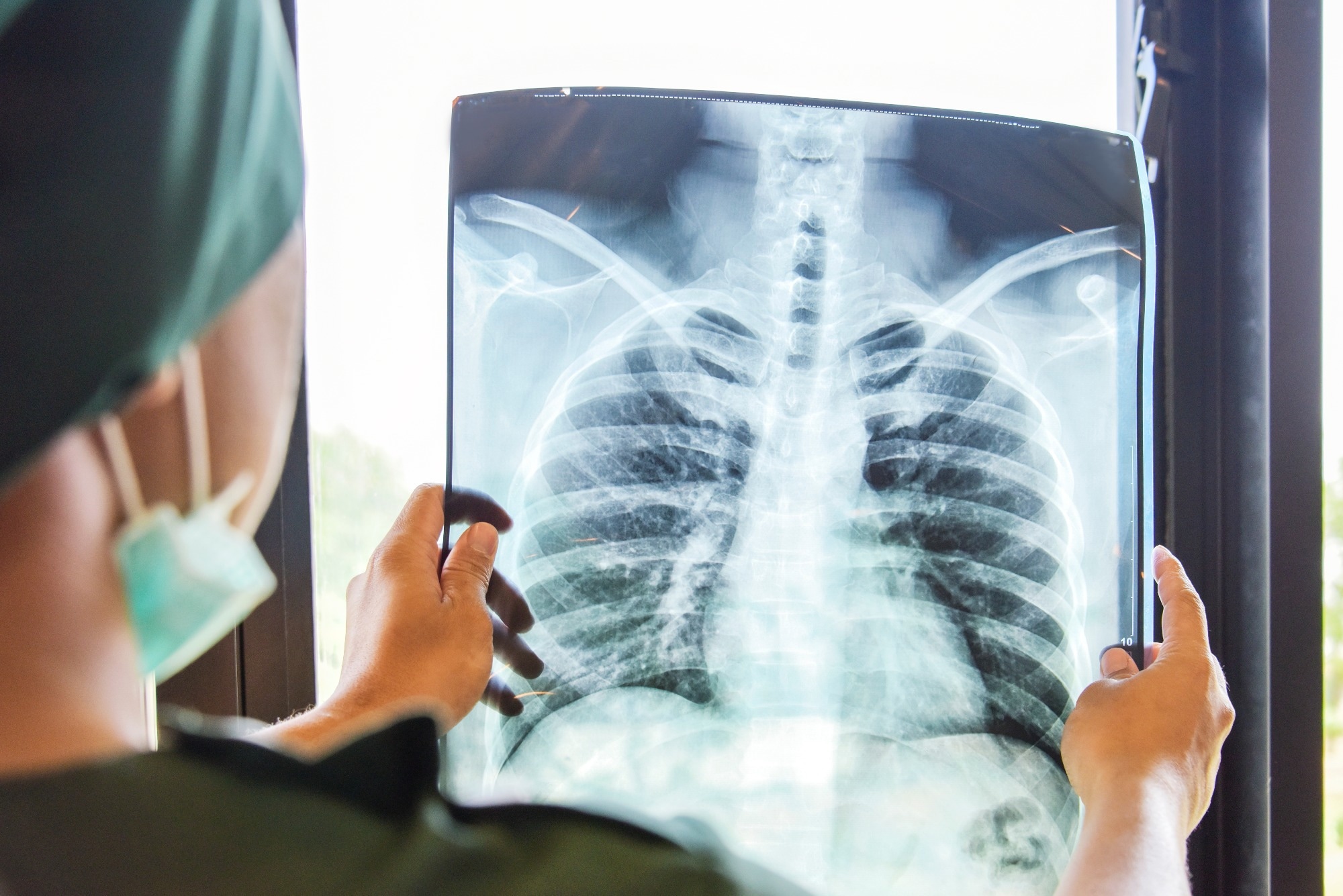Causes and symptoms
Mechanism
Epidemiology
Diagnosis and treatment
References
Further reading
Non–cystic fibrosis bronchiectasis (NCFB) is a chronic inflammatory condition of the lungs associated with respiratory infections and daily cough and sputum.
 Non-cystic fibrosis bronchiectasis. Image Credit: 15Studio/Shutterstock.com
Non-cystic fibrosis bronchiectasis. Image Credit: 15Studio/Shutterstock.com
It can occur due to various factors, including pneumonia, abnormalities of cilia, and immune deficiencies. It most frequently affects the elderly. Patients suffering from NCFB generally experience increased morbidity and worse quality of life.
Causes and symptoms
NCFB has a complex etiology. However, the majority of patients still suffer from idiopathic NCFB.
It is a multifactorial condition and can be caused due to autoimmune disease (e.g., Rheumatoid arthritis), immune deficiency (e.g., HIV infection), cilia abnormality (e.g., primary ciliary dyskinesia), inflammatory bowel disease (e.g., ulcerative colitis), and malignancy (e.g., chronic lymphocytic lymphoma).
Stem cell transplantation, childhood infections (pneumonia), and aspiration have also been found to be causative agents. Organisms like Streptococcus pneumoniae, Haemophilus influenzae, and Pseudomonas aeruginosa have been commonly observed in bronchiectasis.
It has many clinical manifestations, from asymptomatic radiological abnormalities to chronic sputum production. Chronic cough, extensive sputum production, and recurrent respiratory infections are the hallmark symptoms of NCFB. Lethargy, dyspnea, and pleuritic chest discomfort may also be present.
Patients with bronchiectasis frequently have mild, intermittent hemoptysis, as well as anxiety and depression, which can have a negative impact on their quality of life.
Patients with persistent symptoms, especially those with pertinent risk factors, comorbidities, or pre-existing respiratory disorders, should be suspected of having bronchiectasis.
Exacerbations affect one or more of the typical bronchiectasis symptoms, including worsened cough and dyspnea, increased sputum output or purulence, and systemic symptoms. These episodes are typically brought on by bronchial infections.
Bronchiectasis-related comorbidities include asthma, chronic obstructive pulmonary disease (COPD), lung cancer, and cardiovascular diseases.
Mechanism
Changes in the architecture of the airways cause mucus to build up, chronic airway infection, and ongoing neutrophilic inflammation. The widely recognized theory explaining the development of bronchiectasis is Cole's vicious cycle model.
According to this, tissue damage is brought on by the host's inflammatory response to bacteria and foreign objects in the airway. As a result, bronchiectasis develops, which affects the normal evacuation of mucus and promotes bacterial colonization.
Retained sputum can progress bronchiectasis by causing mucous plugs, airway obstruction, obliteration, and damage over time.
Epidemiology
In the United States, bronchiectasis is becoming more common. According to a study, the prevalence rose yearly between 2000 and 2007 by an average yearly percentage change of 8.74%.
Additionally, it was discovered that prevalence rose with aging, peaked between the ages of 80 and 84, and was highest in patients with Asian ethnicities. Over 200,000 people are believed to have bronchiectasis in the UK, making it a medical condition on the rise. It is more prevalent in women and becomes more severe as people age.
Diagnosis and treatment
High resolution computed tomography (CT) scan of the chest is the gold standard for the diagnosis of bronchiectasis. Bronchial wall dilatation with or without thickening is one of the diagnostic signs.
Although not frequently utilized, magnetic resonance imaging (MRI) has been explored in CF and non-CF populations. It has been proven to be equivalent to CT in detecting airway architectural distortion without ionizing radiation. Clinical history, physical examination, thoracic radiography, and blood testing should be used to look for underlying etiology. In order to assess patients with respiratory complaints, spirometry is routinely utilized.
Establishing an underlying cause and managing bronchiectasis comprehensively are critical. As soon as the underlying cause has been found, the focus of therapy should be on breaking the "vicious cycle".
Non-pharmacological mucus clearance, also known as airway clearance techniques (ACTs), is a crucial part of therapy for NCFB to reduce acute problems. More so than other, more invasive techniques, postural drainage has been found to be an effective airway-clearing strategy.
One of the most efficient ACTs is positive expiratory pressure (PEP), which uses a device with a one-way valve to provide an unconstrained effort during inspiration.
Referral to a specialized center for surgical evaluation for lobectomy or segmentectomy may be necessary if the bronchiectasis is localized. In some patients, the use of long-term antibiotics—oral or inhaled—has been utilized as a suppressive medication with additional improvements in exacerbation rates, symptom ratings, and quality-of-life indicators.
Based on the severity of the disease, present-day symptoms, and results from cell culture, these treatments should be carefully adapted. In patients with progressive NCFB, comprehensive care planning and palliative care are crucial.
References
- Choi H, Yang B, Kim YJ, et al. (2021). Increased mortality in patients with non cystic fibrosis bronchiectasis with respiratory comorbidities. Scientific reports, 11(1), 7126. doi:/10.1038/s41598-021-86407-8
- Macfarlane L, Kumar K, Scoones T, et al. (2021). Diagnosis and management of non-cystic fibrosis bronchiectasis. Clinical medicine (London, England), 21(6), e571–e577. doi:/10.7861/clinmed.2021-0651
- Quinn TM & Hill AT (2018). Non-cystic fibrosis bronchiectasis in the elderly: current perspectives. Clinical interventions in aging, 13, 1649–1656. doi:/10.2147/CIA.S143139
- Maselli DJ, Amalakuhan B, Keyt H, et al. (2017). Suspecting non-cystic fibrosis bronchiectasis: What the busy primary care clinician needs to know. International journal of clinical practice, 71(2), e12924. doi:/10.1111/ijcp.12924
- Lonni S, Chalmers JD, Goeminne PC, et al. (2015). Etiology of Non-Cystic Fibrosis Bronchiectasis in Adults and Its Correlation to Disease Severity. Annals of the American Thoracic Society, 12(12), 1764–1770. doi:/10.1513/AnnalsATS.201507-472OC
- McShane PJ, Naureckas ET, Tino G, et al. (2013). Non-cystic fibrosis bronchiectasis. American journal of respiratory and critical care medicine, 188(6), 647–656. doi:/10.1164/rccm.201303-0411C
Further Reading
Last Updated: Aug 8, 2023